Who is “hiding” under the pseudonym Feofan the Recluse
This is Bishop Feofan (Govorov), in the 2nd half. XIX century who headed first the Tambov, then the Vladimir diocese.
You can also find this bishop called “Vyshensky”. However, if other saints are named after their cathedra - for example, Moscow, Vladimir, then St. This does not apply to Feofan.
The name does not mean the diocese, but the monastery of the Dormition of the Blessed Virgin Mary in the village of Vysha, Tambov diocese (now Ryazan), where the saint lived “in retirement.”
But it was there that he became an ascetic and a saint. And, with God’s blessing, he created works that became reference books for many Orthodox Christians.
Russian Spiritual Mission in Jerusalem (1847-1854)
View of Jerusalem, 19th century
In 1847, as part of the Russian Spiritual Mission, he was sent to Jerusalem. The six-year stay in Palestine was of great spiritual and moral significance for Hieromonk Theophan. He visited the holy places of Palestine, Egypt and Syria, ancient monastic monasteries (the famous Lavra of St. Sava the Consecrated), talked with the elders of the holy Mount Athos, and studied the writings of the Church Fathers from ancient manuscripts.
Streets of Jerusalem in the 19th century
In Jerusalem, the future saint learned icon painting and supplied poor churches with his icons and even entire iconostases. Here, in the East, he thoroughly studied Greek and French and became familiar with Hebrew and Arabic.
In 1854, in connection with the outbreak of the Crimean War (1853-1856), members of the Spiritual Mission were recalled to Russia. In connection with the war, the Mission returned to its homeland through Europe. On his way to Russia, Hieromonk Theophan visited many European cities, and everywhere he examined churches, libraries, museums and other attractions, visited some educational institutions in order to familiarize himself with the state of affairs in Western theological science. In Rome, Hieromonk Theophan had an audience with Pope Pius IX. In Italy, Father Feofan, as a great lover and connoisseur of painting, was interested in works of art; in Florence, he examined Raphael’s paintings in detail and acquired for himself many well-executed photographs. In Germany, Hieromonk Theophan became thoroughly acquainted with the teaching of various sciences, especially theology, in educational institutions.
For his work in the Mission in 1855, Hieromonk Theophan was elevated to the rank of archimandrite and appointed to the St. Petersburg Theological Academy as a bachelor in the department of canon law, and six months later - to the position of rector .
While serving as rector of the seminary, he used all his strength to properly guide the young men entrusted to his care, trying, on the one hand, to protect them from the dangers and hobbies inherent in youth, and on the other, to develop good inclinations and introduce good habits so that Upon completion of the seminary course, the students were useful members of the Church and sons of their Fatherland. First of all, he tried to arouse and strengthen religiosity in his pupils. He instilled in them a love for church and worship, instilled zeal for prayer, fasting and other church institutions. On Sundays and holidays, he himself performed divine services, encouraging his students to participate in it with prayers, reading and singing in the choir. At the same time, Father Theophan often spoke in the seminary church about the truths of faith and piety. He was always present at morning and evening prayers at the seminary, praying earnestly with the young men and thereby setting an example for them. To prevent students from being idle during their free time from classes, Father Feofan introduced a drawing and icon painting class at the seminary.
short biography
On November 28, 2014, in his homeland, in the village of Chernava, now the Izmalkovsky district of the Lipetsk region, a monument to the saint appeared.
It stands exactly on the site of the unpreserved house of his parents: priest Vasily Govorov and his wife Tatiana.
The opening of the monument was part of the preparations for the 200th anniversary of the ascetic. After all, George - that is his worldly name - was born on January 10, 1815.
Parents
Yegor's family, as his family called him, was distinguished by its religiosity and piety, being an example for the residents of Chernava.
- Father, priest Vasily, was the permanent dean of the district for 30 years.
- The mother, the daughter of a clergyman, took care of the house and raising children: the Govorovs had four sons and three daughters, and one of the brothers, Simeon, died in childhood.
The saint's sisters later became wives of clergy, and the brothers also served the Church as rural clergy. The most capable of all the Govorov children turned out to be Yegor, who received a spiritual education and then even became a bishop.
"Ringer or Bishop"
The boy grew up cheerful, sociable, and playful. That didn’t stop him from especially loving the services, where he stood for hours, and the ringing of bells. The boy often climbed the bell tower of the Vladimir Church, of which his father was the rector. Here he sometimes helped the bell ringers, or simply watched and listened. And apparently he was praying.
One day he was “forgotten” at the belfry after the service. The servants locked the bell tower and went home. Realizing that his parents would miss him and scold him, the resourceful Yegor thought of descending to the ground using a rope that stretched from the main bell.
The prank did not go unnoticed, but the father did not swear, only saying:
“Well, Yegorushka, you will either be a bell ringer or a bishop!”
These words turned out to be prophetic.
Home education and school education
When Georgy grew up a little, his father began to take him to services as a sexton. Education children o. Vasily received homework: they were taught either by the priest himself, or by their mother, Tatyana Ivanovna. She, for example, as the saint recalled, knew the lives of the saints so well that “she was not inferior to theologians.”
Interesting fact
George had another spiritual mentor, even if he was no longer on earth - St. Tikhon Zadonsky. The family often made pilgrimages to his resting place, although the saint of God was glorified by the Church only in 1861. Thanks to frequent visits to his monastery, Yegor, the son of a lay priest, saw monastic life from childhood.
The boy began to learn to read and write at the age of seven. Relatives recalled that Fr. Vasily even performed a prayer service to the prophet. Naum, for whom many parishioners who loved the priest prayed. It soon turned out that Yegor studied quickly, with desire, despite his restlessness, so his father decided to send him, only eight years old, to the theological school in Livny.
Relatives recalled that at first his studies were not easy, but after two years Georgy was among the best students who were sent to the Oryol Seminary. Here, too, the young man showed success, as they wrote in the documents, “excellently good.” It is believed that then he began to seriously think about the monastic path. The seminar note notes:
George “is edifying in his dealings with his comrades; sets an example of hard work and good morals; meek and silent,” like a monk.
Academy
At the same time, George still loved science and read books voraciously. By the end of the seminary, he, of course, wanted to continue his education. However, he understood: most likely, the fate of a rural priest awaited him. In addition, the rector of the seminary, Archimandrite Sophrony, demanded that the students know the textbook by heart, and this is precisely where the future saint was not strong, even if he was the first student. So the rector would not recommend him to the Academy.
But when he was almost a graduate and began to look for a rural parish, it turned out that the Oryol bishop, His Eminence Nikodim, personally ordered to send him to the Kyiv Theological Academy - the only one from the entire graduating class.
George plunged headlong into his studies at the blessed place of asceticism of his beloved Pechersk saints. He would later call the Kiev Pechersk Lavra an “unearthly monastery.” It was here that he fell in love with the monastic way of life, long services, and solitude. Studying continued to make me happy.
Theophan the Recluse. Unfinished self-portrait
His classmate, later Metropolitan, famous Church historian, theologian, Macarius (Bulgakov) recalls:
“No one wrote better than him, only due to his modesty he could not read his works loudly.”
Many researchers of the saint’s biography say that the death of his beloved parents finally pushed George to choose his future path. The mother died in 1838, the father a year later.
On February 27, 1841, George accepted monasticism with the name of St. Theophan the Confessor. He graduated from the Academy as a hieromonk. His graduation essay “Review of Under-Law Religion” (about the religion of the Jews of the Old Testament) was read even in the Holy Synod. Metropolitan Philaret (Drozdov), himself a brilliant scientist, personally gave a brief review:
“This work contains so much information and considerations about the Law of Moses that they serve as sufficient evidence of the knowledge of the author, giving him the right to a master’s degree.”
Master of Theology in the Field of Education
Later, the saint himself compared himself to a ball rolling back and forth - wherever it was directed. This is an image of his humility, obedience, but there is a certain bitterness here. Dreaming of solitude and asceticism, the “learned monk” immediately after his ordination found himself the rector of a theological school in Kyiv, forced to immerse himself in administrative affairs. But this was just the beginning:
- a year later he was sent to Novgorod as a seminary inspector, teacher of logic and philosophy; obedience lasted three years;
- since 1844 Feofan was already at the St. Petersburg Theological Academy; soon he will also be appointed inspector here; despite the fact that he was “unbearably” burdened by this work, the hieromonk coped well, and wrote about his torment only in letters to his confessor: “I would have gone to church and sat there”; but no:
- from 1847 to 1853 Hieromonk Theophan works in the Spiritual Mission in Jerusalem; the blessed Holy Land gives him an enormous amount: here he improves his knowledge of languages, learns icon painting, begins to translate the Greek “Philokalia” into Russian; when the Crimean War began, the mission was recalled; I had to return through Europe; so o. Feofan managed to see cultural monuments and visit legendary temples; he is also the head of the mission, Archimandrite. Porfiry, they didn’t even get a reception from the Pope, Pius IX; all this enriched his knowledge about Europe, its culture, and non-Orthodox Christians.
Upon returning home, God's lessons in obedience continued: from 1855, having barely begun teaching at the already familiar Theological Academy of St. Petersburg, Fr. Feofan, already an archimandrite, moves to the position of rector of the Olonets Theological Seminary, an educational institution that does not even have its own premises.
Having barely had time to deal with his problems, he learns that he is again being sent to the East - as the rector of the embassy temple of Constantinople, as he knows the region and speaks languages. Can not argue with that…
He lived in Constantinople for less than a year: the archimandrite’s father was recalled again now - to the post of rector of the same St. Petersburg Theological Academy.
Later, looking back at this time, marked by intense intellectual work, many church and secular awards, but so filled with vanity, far from truly monastic life, prayer, solitude, he will say:
“True obedience obeys without seeing any reason and despite one’s reluctance.”
Such was the lesson taught to the learned monk not in a monastery, where he would humble himself before the brethren, but in the midst of worldly life, which probably made him grieve more than once, perhaps grumble humanly, but still repeat over and over again, turning to the Lord:
“Not as I want, but as You…”.
The main thing of obedience was still ahead.
Bishopric
In February 1859, the rector, Archimandrite Theophan, received another award: to commemorate the 50th anniversary of the Academy, he was awarded the Order of St. Vladimir 3rd degree.
And a few months later, he was appointed Bishop of Tambov and Shatsky. It was not only a large, very populous diocese (there were more than 2000 priests and deacons under the leadership of the Bishop), but also, as they would say now, problematic. Schisms and sectarianism flourished here. And the numerous clergy were poorly educated.
At his new obedience, Vladyka set to work with the same zeal: during his short reign of the Tambov flock include:
- publication of the collection “Letters on Christian Life”;
- manuals for priests “How to write a sermon”;
- the transformation of the Kazan Monastery into a center for preaching, where the clergy were directly taught this work;
- restoring order in the Seraphim-Diveevo Monastery, torn apart by unrest: it was deliberately given to the Tambov diocese for several months, knowing the wisdom of the Bishop - with his experience, intelligence, tact, he will certainly reconcile the warring parties.
Work on the Tambov field continued until 1863, when Vladyka was again sent to a new obedience - to the Vladimir diocese. More than a million inhabitants, about 10,000 clergy, 28 monasteries, 270 schools... Truly, “the harvest is many, but the workers are few.” The Bishop again had to work to correct the spiritual life of his flock and fight against schisms and sects.
The Bishop opens an Orthodox brotherhood and is working on a women's diocesan school. And he writes bitterly to his spiritual friend, St. Ignatius (Brianchaninov) , already living alone in retirement:
“I’m completely fussed. And very often I rush to follow your path. How would this work out! I can't see the gate due to my myopia. Sometimes you are ready to take up the pen and write a petition about it; Yes, something is bothering me in my chest. And I remain with one desire. We will sit by the sea and wait for the weather. And the sins are still weighing me down, and the passions are still hitting my sides...”
"To serve in another way"
The saint wrote a petition to the Synod on March 11, 1866. The active, intelligent, beloved bishop had recently turned only 51 years old. He, of course, had long been in mind as a future metropolitan, a member of the Synod. So the “demarche” was not understood at first. Even St. It seemed to Philaret (Drozdov), known for spiritual wisdom, that Vladyka was abandoning the cross given by the Lord and leaving obedience.
The Holy Dormition Vyshensky Monastery is the place of the spiritual exploits of St. Theophan the Recluse. Photo 2015
He had to explain:
“I am looking for peace so that I can more calmly indulge in the activities I desire... with the indispensable intention that there will be a fruit of labor that is not useless and not unnecessary for the Church of God. I have in mind to serve the Church of God, but to serve in a different way.”
The Synod, albeit with dissatisfaction, granted the request. Vladyka was first appointed rector of the Assumption Monastery on Vyshe. But after a while he left management, and during the Great Lent of 1872 he finally retired, locking himself in a cell, accepting the long-desired feat.
Why did a highly educated man at the peak of his career go into seclusion?
Subsequent years showed that the saint was not guided by his own will. The Lord, seeing that the ascetic, having gone through all the lessons of humility and obedience, had matured to be not just a bishop - the spiritual leader of many flocks, blessed not “peace”, but new labors - for the sake of saving the souls of his neighbors. Thus, St. Petersburg once emerged from many years of seclusion to the feat of senile service. Seraphim of Sarov, ripe for the Kingdom of Heaven. But Bishop Theophan needed... just to retire there from the cycle of worldly affairs!
Museum exhibitions of the Holy Dormition Vyshensky Monastery
What is the meaning of the shutter
The Lord himself did not consider that he was performing a feat at all:
“There’s nothing reclusive here. I locked myself away so as not to be disturbed, but not in the form of the strictest asceticism, but in the form of unhindered bookishness... I laugh when someone says that I am in seclusion. This is not the same at all. I have the same life, only there are no ways out or tricks. The seclusion is real - don’t eat, don’t drink, don’t sleep, don’t do anything, just pray... I talk to Evdokim, walk around the balcony and see everyone, correspond with each other... I eat, drink and sleep to my heart’s content. I have a simple solitude for a while.”
But only in the silence of this solitude could he comprehend his enormous life experience, put it on paper for the benefit of the souls of many people. It was this work, blessed by the Lord, that became the main thing for the bishop “in retirement.” He again performed obedience - as he had long been accustomed to:
- translated patristic texts;
- endlessly answered letters from spiritual children; Up to forty of them came daily - the saints wrote a response to each;
- He served in a small church next to his cell, which he himself consecrated in honor of the Epiphany of the Lord.
Death and glorification as a saint
Thus passed 21 years of “paradise,” as the saint put it, of a life full of prayer and work. In recent years, Vladika was very ill, blind in one eye, but never complained. On the patronal feast of his cell church, Epiphany, January 19, 1894, he died quietly. The cell attendants were at the festive service, so at the hour of death the saint was alone.
The glorification of the saint took place at the Council in 1988, timed to coincide with the 1000th anniversary of the Baptism of Rus'. By this time, his honest remains had already been found and carefully preserved.
Where are the relics of the saint
It is known that the saint was buried in the Vyshenskaya monastery, in the Church of the Kazan Icon of the Mother of God. After the monastery was closed during the Soviet years, its premises were occupied by various Soviet institutions, and the Kazan Church fell into disrepair. It is known that there was an attempt to plunder the saint’s grave, but the relics themselves remained hidden, inviolable.
Cancer with relics
In 1973, several clergy managed to enter a closed church on the territory of a psychiatric hospital, which occupied the premises of a former monastery. These were Abbot Mark (Lozinsky) from the Trinity-Sergius Lavra, hieromonks Eleutherius and George . With them was also the rector of the only functioning church in the area, St. Sergius in the village of Emmanuilovka, Fr. Georgy Glazunov . They managed to clear the saint’s resting place of debris and serve a memorial service. After some time, they visited the grave again - then they managed to find the remains of the coffin and take away the honest relics.
For the next 14 years, they, as well as the tombstone from the grave, which they also managed to remove, were in Emmanuilovka.
O. George, rector of the temple, recalls:
“Over the years there have been many reports of miracles. Sometimes I regret that I did not write them down, and some have already been forgotten... One boy, who had not walked since birth, was brought from afar three times, I laid him right on the relics, like a baby, although he was two and a half years old. My parents first bathed him in the spring of St. Theophan, and then brought him, and I laid him on the relics. And so, when they brought him in for the third time, during the service he begged to fall on the floor, his mother put him down, and he ran. The parishioners say: “Why don’t you take the child, he’s running around the church and preventing you from praying!” - and she stands and cries with joy throughout the service, she can’t say anything: the boy hasn’t walked since birth, but here he ran!..”
Meanwhile, the canonization of the saint drew attention to the abandoned monastery in Vyshe. By 1990, some of its buildings were returned to the Church, and since 1993 the monastery was revived - now as a convent, although initially the monastery belonged to one church, and the sisters had to live outside the territory still occupied by the mental hospital.
Only on June 29, 2002, the saint’s relics were transferred to the revived monastery. Now you can still venerate them in the Kazan Cathedral, but the shrine is not hidden, as before the revolution, but in a shrine.
Introduction to monasticism
In October 1840, George submitted a petition to the leadership for tonsure as a monk. In February 1841, the rector of the academy, His Eminence Jeremiah, took monastic vows. At the same time, George received a new name, Theophan, in honor of Saint Theophan the Confessor.
In April 1841, the monk Theophan was ordained a hierodeacon, and in July - a hieromonk. In 1841, he graduated from the Theological Academy, defending his dissertation and receiving a master's degree.
In the same year, in August, Father Feofan was appointed to the post of rector of the Kiev-Sophia Theological School and began to perform his duties. In addition to working as a rector, he taught Latin. In addition, during this period he was engaged in an in-depth study of the work of the holy fathers of the Church.
In 1842, he received a new appointment - to the Novgorod Theological Seminary. There he served as an inspector and taught psychology and logic. His main thought as a seminary teacher, and he constantly reminded his students of this, was that the first place in their lives should be to please God, and not to dry scientificism.
In 1844, Father Feofan, with the blessing of the church authorities, took the position of teacher in the department of Moral and Pastoral Theology at the St. Petersburg Theological Academy. And in 1845 he became an assistant inspector of the academy.
Reverence
His, where the saint spent the last years of his earthly life, is the Vyshensky Assumption Monastery. In addition, 7 churches and 2 chapels have now been dedicated to the saint.
Vyshensky Monastery
Now the relics of the saint are the main shrine of the monastery, along with the Vyshinskaya Icon of the Mother of God. In addition, 4 km from the monastery, in Emmanuilovka, on the site of the former location of the relics, there is a spring consecrated in honor of the ascetic. Coming for St. Feofan, pilgrims are sure to visit it. Now a record of healings through prayers to St. is being kept here. Feofan.
In 2015, the monastery solemnly celebrated the 200th anniversary of the saint: many readings, conferences, but most importantly, new editions of his works allowed thousands of people to touch his legacy.
Temples
The very first church of the saint is known on Tambov land, the place of his episcopal service.
Wooden church in the name of Theophan the Recluse in the village. Magistralny, Irkutsk region, built in 1998-1999.
This is a wooden baptismal church at the Intercession Cathedral in Tambov. Later, in 2009, construction of a large temple began here, which, however, has not yet been fully completed, although regular services are held here.
Interesting fact
Churches of the saint also operate in the Moscow, Ryazan, Yaroslavl, and Tambov regions. The easternmost of them is located in the village of Magistralny, Irkutsk region. This is a small wooden church, erected in 1999 through the efforts of district authorities and local timber industry enterprises.
Icons and paintings
Fragment of the painting of the Church of the Archangel Michael in Pushchino, Moscow region. I. Samolygo, PSTGU teacher with a team, 2010
Icon of St. Theophan. Y. Grechin, 2010
Death
Theophan the Recluse died in the monastery in 1894. Cardiovascular diseases, rheumatism and neuralgia caused him pain and discomfort. Progressive cataracts led to the fact that in 1888 the clergyman became blind in his right eye. The cause of death was old age and related illnesses.
Sarcophagus of Theophan the Recluse
The monk's funeral service took place on January 11. A large number of people came to say goodbye to Father Feofan. The burial of the clergyman was in the Kazan Cathedral of the Vyshenskaya Hermitage.
The relics of Theophan the Recluse were transferred, and today they are kept in the Church of St. Sergius of Radonezh, where an akathist is read in honor of the deceased. Thanks to modern technologies, any Internet user can view the photo of the clergyman.
Proceedings
The most complete collection of the saint's works to date, the publication of which was completed by 2010, contains 25 volumes. And, probably, his most read work by Christians is “Thoughts for Every Day of the Year,” short reflections that are now often placed in church calendars.
"The Outline of Christian Moral Teaching"
According to the author himself, the work, created in 1891, explains to the believer what exactly he must do for his salvation. From the foundations of Christian morality, which lie in the “economy of our Salvation” by God, life in His church, the author moves on to the rules of Christian life in the world.
Interpretation of the Gospel – “Gospel Story”
Today, in the complete collection of works of the saint, it ranks 25th, the last volume.
The book was not published during the author’s lifetime; it is the fruit of the painstaking work of modern researchers of his work. This is a parallel interpretation of all 4 Gospels, a systematic presentation of the events of the earthly life of the Lord.
The index provided with the book helps you to navigate the understanding of a particular passage.
“What is spiritual life, and how to tune in to it?”
This is also a modern edition of the saint’s letters addressed to one of his spiritual children, a certain young woman taking her first steps in conscious church life.
There are 80 letters. The short headings given to them by the publishers reflect the contents of the messages.
This allows the believer who seeks St. Feofan's answer to specific questions of spiritual life, it is better to navigate through the book.
However, it is better to read it in full. From the pages of his letters the saint appears as a wise, very kind mentor. A monk and ascetic, he not only respects, but deeply values family. For example, this instruction of his will most likely be understood and supported by many:
“And I was at a loss: what would it be? Here's what! Grandma was a little sick. Well, grandma is a victorious word. There is no warmer place for granddaughters than grandmothers; no, and for grandmothers, faces are more valuable than good granddaughters. And we must thank God for this. And you console your grandmother more often and listen more carefully to what she says. The elders have wisdom acquired through the experiences and labors of life. And they often casually, in simple phrases, express such wise lessons that you won’t find even if you look for them in books.”
And here is a very serious instruction - advice to someone who has lost prayer:
“Where did your prayer go?!” After all, she went well, and you already felt her good effect in your heart. I'll tell you where she went. Having prayed once or twice fervently and with warmth... having experienced such immediate help as a result of prayer, you thought that your prayer had already been established and therefore there was no need to worry much about it: it would go well on its own.
Having allowed such a thought, when you stood up for prayer, you began to read the prayers carelessly and hastily, and stopped watching your thoughts. Because of this, attention was scattered, thoughts diverged in different directions - and prayer was not prayer. They did this once or twice, and the prayer completely disappeared. Start acquiring prayer again and asking the Lord for it.
From this you will learn that you should never consider any spiritual work as established, and especially prayer, but always behave as if you were beginning to perform it for the first time.”
“Thoughts for every day of the year according to Church reading”
This is a collection in which the saint offers a brief interpretation of passages of the Gospel and the Epistles of the Apostles, which are read every day in church. Unlike many other works of the Bishop, this work went through more than one edition during the saint’s lifetime.
Interesting fact
“Thoughts” first appeared in the publishing house of the Panteleimon Monastery of Mount Athos (1881).
In Russia they were published at least 5 times after that, the last one 2 years before the revolution, in 1915.
Translation of the Philokalia
The saint began to work on this fundamental work even before his ordination as a bishop, during his stay at the Spiritual Mission in Jerusalem. The compiler himself calls it “an interpretation of the hidden life in the Lord Jesus Christ.” The translation of the works of the holy fathers of antiquity, their words dedicated to inner life, the fight against passions, and the Christian spiritual order, was first done by St. Paisiy Velichkovsky in 1793. However, as St. writes. Feofan in the preface, the translation had some imperfections, and much was incomprehensible to the 19th century reader.
Work of St. Feofana received the name of the “New Russian” translation of the “Philokalia”. It is this five-volume work that has been republished many times over the past decades.
Many rightly consider the Philokalia to be monastic reading, so there are also short excerpts from it intended for the laity. This collection is excerpts from the work of St. Feofan, only one volume - compiled in 1929 by Archimandrite Yuvenaly, who was the rector of the Kazan Monastery in Harbin, China, where there were then many Russian emigrants who fled from Soviet power.
Edited by Fr. Juvenalia “Philokalia selected for the laity ” has also been republished several times in recent years in Russia.
Other
Among the hundreds of works of the saint, beloved by believers, are also:
- two collections of sermons, 1859 and 1861; the first is called “The Word of Archimandrite Theophan” , appeared even before his episcopal consecration; the second came out of the press of the ministry on Tambov land;
- lectures united under the general title “The Path to Salvation” (1868); already during the author’s lifetime the work went through five editions;
- published as a separate book on the largest Psalm 118 (“Blessed are the blameless on their journey...”) (1891);
- the saint's letters, which he allowed to be published during his lifetime; Thus, in 1892, the collection “Letters to Various Persons on Objects of Faith and Life” appeared;
- editions of letters published after his death are the same 20-40 letters a day that he wrote to his spiritual children; the precious messages were carefully preserved by them, and in 1898-1901 the admirers of the Bishop managed to compile several collections of them; these are “Letters on the Christian Life” (as many as four issues);
- the saint’s work “Ancient Patericon”, published in 2009; until that time, its original manuscript (305 sheets) from the saint’s pen was kept on Mount Athos by the brethren of the Russian Panteleimon Monastery;
- Interpretation of the Epistles of St. ap. Paul , which was also published by the Panteleimon Monastery, partly during the author’s lifetime, partly after his death (1890-1895); it contains 8 volumes; to date, a revised, more modern edition based on the Athos edition has been published: for example, an index compiled by the monks of the Pskov-Pechersky Monastery has been added to it;
- interpretations of selected psalms: drafts of this work were found in the saint’s papers after his death; At the same time these interpretations were published, and in recent years they have been published again;
- another translated work by the Athonite elder St. Nicodemus, "Invisible Warfare" ; Nowadays Orthodox Christians, many of whom love this book, do not always pay attention to the name of the translator, thanks to whom it was published in Russian
- a book about Christian psychology “The Incarnate Economy” ; Nikolai Vasilyevich Elagin planned to publish this work of the saint in 1889; however, for unknown reasons, the work was not published. It was possible to fulfill the saint’s blessing only 120 years later, in our days.
Reclusion
In 1872, the saint actually began to lead the life of a recluse. He locked himself in a separate room. The circle of his visitors was limited to an extremely small number of people. In his cells, he set up a small house church, and he himself served the Divine Liturgy in it: at first - on Sundays and holidays, and in the last years of his earthly life - every day.
In addition to prayer, he devoted a significant part of his daily routine to reading, analyzing correspondence and composing reply messages, and theological works. At the same time, guided by ascetic instructions, he paid a lot of attention to physical labor: he was engaged in icon painting, wood carving, and sewing clothes for himself.
On January 6, 1894, the saint quietly departed to the Lord. The funeral service for the archpastor took place on January 11 in front of a huge crowd of people. The bishop's body was buried in the Vyshenskaya Hermitage, in the Kazan Cathedral.
Teachings and instructions in letters
It is they who usually turn out to be the most valuable for laity who cannot bear the high asceticism of the Philokalia or the Ancient Patericon.
Beginners who have barely entered church life sometimes do not know who to ask this or that question of interest. Then the works of the saint come to the rescue - it is not for nothing that the hierarchy wisely blesses the publication of their excerpts in church calendars, a very short daily reading.
The thought of a saint suddenly sinks into the soul of a layman, hurrying to work or study, immersed in vanity. And one day the time comes when he opens the letters of the saint or his “Gospel History” .
There is no salvation outside the Church
Many letters and other works of the saint are devoted to the disease of that (and our) time - de-churching. Idle reasoning that “you can pray at home” and “God is in my soul” is also not an invention of modern times. Here is what the saint writes about this:
“You need to know the truth and believe in it: where will you get it besides the Church, which is “the pillar and ground of the truth” (1 Tim. 3:15)? You need to receive grace: where will you find it, except the Church, the keeper of the Sacraments, without which grace is not given? You need to have the right leadership both in the matter of conduct and in the matter of life: where will you find it besides the Church, in which alone there is a divinely established and God-supplied shepherd? You need to be united with the Lord Jesus Christ: where will you be worthy of it, if not in the Church, of which Christ the Lord is the Head?”
“Whoever says: “Even by praying at home, I can attract the Heavenly Spirit to myself,” is like a person who hopes to quench his thirst with the mere imagination of water.”
Statements
The short, precise words of the saint, who knew how to express the main thing in a couple of phrases and touch the soul, were often quoted. Here are just a few of his most famous sayings.
Museum exhibitions of the Holy Dormition Vyshensky Monastery
About the Jesus Prayer
“Doing the Jesus Prayer is simple: become attentive in your heart before the face of the Lord and cry out to Him: “Lord Jesus Christ, Son of God, have mercy on me!” It’s not a matter of words, but of faith, contrition and surrender to the Lord. With these feelings you can stand before the Lord without words... and this will be prayer.”
About passions and the fight against them
“Sin begins with lust. And this thing can always be avoided. Of course, it would be better not to see or talk, but there is no possibility. Therefore, patience is required, self-care, guarding the heart and struggling with oneself. The Lord is near!.. St. John Kolov says: “When a beast approaches, I climb a tree.” We must resort to the Lord"
“Despite all our weaknesses, we believe that the Lord does not want the death of a sinner and that, therefore, when we do not willingly surrender to weaknesses, He will not allow us to fall. A strong wind will bend some trees all the way to the ground, but the tree remains on the root and, as soon as the storm subsides, it straightens up. This happens from passions... Let them rage, but the root just needs to restrain itself... the root is the decision not to succumb to sin by inclining towards it, even death.”
About humility
“The enemy usually runs up and says: don’t let go, otherwise they’ll peck you. He's lying. The best protection from being pecked is humble compliance.”
“Humility is hard to come by. You can consider yourself humble without having even a shadow of humility. Just thinking will not pacify yourself. The best or only true path to humility is obedience and renunciation of one's will. Without this, you can develop satanic pride in yourself, being humble in your word and body position.”
About self-indulgence
“The presence of self-love is a sign that the first decision to work for the Lord was formed incompletely and unsuccessfully. This decision has two ends: one - let him deny himself... and the second - let him come after Me. The first requires the complete suppression of egoism or self-love and, consequently, the prevention of self-indulgence and self-pity, neither great nor small. Consequently, in whomever they are, the solution was incomplete.”
“You write to ask me to pray to deliver you from self-indulgence. What should we pray about? God won't hear. He will hear prayer only for those who are not self-pleasing. And God hears every man himself only when he does not suffer from these firstborn daughters of sin. For lack of self-pity and self-indulgence, the Lord only gives grace and prosperity.”
About the soul
“The soul - a spiritual being - is not a manifestation of some other force, like a rainbow, but is an independent, special personality, freely rational, whose normal state is life in communion with God, who honored it in creation with His image.”
About the knowledge of God
“The scope of God’s knowledge is limitless. On earth, the revelation of God has already been completed; there is nothing to dream about the highest: we have everything we need; learn and live by it. The Christian revelation ahead does not promise new revelation; but only that the Gospel will be known throughout the world, and that this omnipresence and universality of the knowledge of the Gospel is the limit of the existence of the present order of things. Then faith will weaken, love will dry up, life will become a burden, and the goodness of God will put an end to the world.”
About patience
“We see that everyone is trying to escape what they have to endure, but they still can’t escape, even with great resources. Why is this so? Because they took the wrong road. We must take the path of God’s commandments and complacently endure what we have to endure, then this very thing that we endure will begin to exude consolation.
This is paradise, despite its disgusting appearance! Those who want to establish paradise on earth in any other way are only working in vain. The wise one also said to them: “Vanity of vanities!”
About false gods
“Whatever you rely on in life is what God is for you. If it’s about estates, then estates are your god; if in power, power is your god; if on something else, then this other thing is your god. When the true God wants to convert someone to Himself, he first destroys the false gods, so that, having experienced their unreliability, he will quickly and sincerely turn to Him.”
Other interesting thoughts
“Everything that unrestrained young men usually spout will later echo in old age with illnesses and infirmities.”
“Health is like a horse: if you drive it, there’s nothing to ride.”
“Please keep in mind, when sorrows occur, that it is the Lord who is paving the way for you into His Kingdom, or even more: He is taking you by the hand and leading you.”
“Who told you that it is difficult to escape? You just have to want and get down to business decisively - and salvation is ready.”
Calendar cover
Studies
The boy George received his initial education in his parents' home. Pious parents raised him in the church spirit, so that from early childhood he developed a strong love for the Church. It was not without reason that he later noted that churchliness is the most powerful means of properly raising children.
Livensky Theological School
In 1823, Georgy entered the Livensky Theological School and six years later (in 1829), among the best students, he was transferred to the Oryol Seminary . It was then headed by Archimandrite Isidore, later a famous hierarch of the Russian Orthodox Church.
Georgy Govorov studied the sciences taught with great interest, but psychology lessons aroused his particular interest.
During his years of study, after a pilgrimage to the Zadonsk Monastery, where the relics of St. Tikhon of Zadonsk, which at that time had not yet been glorified, rested, George developed an extraordinary, ever-increasing reverence for St. Tikhon of Zadonsk.
In 1837, after graduating from the seminary, the future saint entered the Kiev Theological Academy . Everyone at the Academy remembered him as a modest and reverent young man. As a student at the Kyiv Theological Academy, he visited the Lavra Caves many times. Here, obviously, the idea of renouncing the world matured in him.
The significance of the work of St. Theophan for modern man
They say that he predicted the revolution 50 years before it. Even his works, and the most published of them, “Thoughts for Every Day of the Year,” are filled with denunciations of “modern unbelievers” and growing atheism. Many saints of God saw what was happening then.
It is not without reason that the Lord Himself blessed His servant for an unusual feat, not immediately understood by many: not so much to speak as to write about the truths of faith. A difficult time was coming for the loss of spiritual values, when “do not do goodness, not even one” (Ps. 13:3), and believers were left without spiritual fathers for decades.
In the darkness of persecution, which seemed to have no end, there remained the writings of the saints, the memory of their lives, faith - which they managed to carry through decades of atheism, and... revive in our days? Perhaps it is said loudly. Our compatriots, who want to return to the “embraces of the Father,” have been rushing around in search of meaning for the past ten years, suffering from disbelief absorbed from school years, from pride, self-indulgence, and passions.
It is providential that the writings of the saint, a true ascetic monk, were addressed specifically to the laity of those years. And, as it turned out, modern times.
Let's stop amid the bustle and open the church calendar before leaving for work. Let's read his short words. It won't be long at all. And maybe we’ll understand something about ourselves and the world.
Natalia Sazonova
Everyone will be cured
In the evening, children ride bicycles in the large courtyard in front of the Assumption Church. Cars drive up to the porches, laundry is drying, a lonely old woman is “walking” on a chair in front of the wooden stairs of her “entrance.” Just a year ago, the picture was complemented by mental hospital patients crossing the territory of the monastery with pots in their hands. A year ago, the psychiatric hospital left the monastery territory, but some employees still live in the former monastery buildings they rented from the state. “We lived normally together. What should we share? In a sense, we are also being treated here, we are undergoing a course of special therapy, so to speak,” smiles the dean of the monastery, Mother Tatyana. Now there are a little more than twenty sisters in the monastery. Some of them work as obedients in the monastery monastery, not far from Vysha in the town of Bykova Gora, formerly the estate of the Naryshkin princes. The monastery has a subsidiary farm there. “Of course, it’s difficult for us, just as it’s difficult for a divided family. You have to do a lot twice. Two kitchens, two guest houses, two vegetable gardens. After the hospital vacated the buildings, there were more worries. Previously, we had obediences in the embroidery workshop. Now we can’t afford it, but we still accept pilgrims,” says Mother Tatyana. It’s worth seeing once how sisters communicate with each other to understand that the word “family” is quite applicable to these relationships. Here is one nun telling another something in a passionate, energetic whisper. She listens sympathetically, nods and mechanically corrects her sister’s apostle. So that the ribbons lie beautifully. A special thing is the museum. This is the building in which Bishop Theophan once lived in his retreat. Strange fate - the psychiatric hospital also used him for isolation. Particularly seriously ill patients were kept there. All that remained of the saint were the walls and the staircase, the balusters of which he himself carved, and the museum arose from archival photographs and antique objects donated by benefactors, replicating the everyday interior of Bishop Theophan’s rooms. In the exhibition, the sisters tried to reproduce the reclusive life of the bishop, rich in various activities. In addition to correspondence, Saint Theophan also worked as a carpenter, played the violin, learned to play the harmonium, experimented with photography, painted icons, and subscribed to rare scientific literature in foreign languages. One can assume that he didn’t even have enough time for everything.
Troparion, kontakion, magnification
Troparion to St. Theophan the Recluse, tone 8. Teacher of Orthodoxy,/ teacher of piety and purity,/ Vyshensky ascetic, St. Theophan, the wise God,/ with your writings you have explained the word of God/ and you have shown to all the faithful the path to salvation.// Pray to Christ God that our souls may be saved .
Translation: Teacher of Orthodoxy, teacher of piety and purity, Vyshensky ascetic, Saint Theophan, God-wise, with your writings you explained the word of God and showed all believers the path to salvation. Pray to Christ God for the salvation of our souls.
Kontakion to Saint Theophan the Recluse, tone 4 To the Epiphany of the same name, / to Saint Theophan, / with your teachings you have enlightened many people, / with the angels you now stand before the Throne of the Holy Trinity, / / unceasing prayers about all of us.
Translation: Same name with Epiphany (Theophanes is the same root as the Greek Θεοφάνεια - Epiphany), you enlightened many people with your teachings, now standing with the angels at the Throne of the Holy Trinity, pray without ceasing for all of us.
Tambov diocese (1859-1863)
In 1859, Archimandrite Feofan was named Bishop of Tambov and Shatsk . The bishop had to endure a lot of worries and labors while managing the Tambov diocese. The ministry of Bishop Theophan lasted only 4 years. But in this short time, with the extraordinary meekness of his character, rare delicacy and sympathetic attention to the needs of his flock, he managed to become close to his flock and win everyone’s most sincere love. Saint Theophan proved himself to be a zealous servant in all spheres of church life. He accompanied almost every service with a sermon, and his words, coming from the heart and breathing with deep conviction, attracted numerous listeners. With the assistance of Bishop Theophan, many parochial schools, Sunday schools and private literacy schools were opened.
Among his concerns about managing the Tambov Diocese, Saint Theophan also found time for literary activity. His theological work “Letters on Christian Life” , which contains an entire system of Christian moral teaching.
In 1861, Bishop Theophan took part in the opening ceremony of the relics of St. Tikhon of Zadonsk. This event made a great impression on the Tambov archpastor and served as a special grace-filled sanctification of his own ministry.
Prayer
Oh, Holy Hierarch Father Theophan, the most glorious and wonderful recluse of the bishop, God's chosen one and servant of the Mysteries of Christ, God-wise teacher and excellent expounder of the apostolic words, fatherly goodness of holy tales to the writer, of Christian piety, graceful preacher and spiritual life, skillful mentor, zealous monastic deeds to the zealot and to all people of grace I intercede!
Now to you, the God who stands in Heaven and prays for us, we fall down and cry out to you: ask the all-generous God of the Russian Church and our country for peace and prosperity, the saint of Christ - the Divine truths I am a worthy guardian, a good nourishment for the flock, a fair shame for false teachers and heretics; to those who strive - humility, fear of God and purity of soul and body; for the teacher - knowledge of God and wisdom, for the students - zeal and God's help;
and to all Orthodox - confirmation on the path to salvation, so that together with you we glorify God's Power and Wisdom, our Lord Jesus Christ, with His Beginning Father, with the Most Holy, Good and Life-Giving Spirit Hom, now and ever, and unto the ages of ages. Amen.
Vladimir Department (1863-1866)
Vladimir 19th century
In 1863, he was transferred to Vladimir, where he opened a women's diocesan school with a six-year period of study and began publishing the Vladimir Diocesan Gazette.
But the extensive practical activities of diocesan administration were not sweet to the archpastor’s soul. As has already been said, from a young age he strove for solitude and saw the ideal of monasticism in the complete renunciation of all everyday concerns. And now, after 25 years of service to the Church in various fields, the saint found it timely to fulfill his always-present desire.
Consolation of a mother who has lost her children
“You have focused your attention entirely on the sad side of the matter, and do not see God’s care for you?! And she really is. Can't you touch it?! That's what she is. It is not tangible in the present, but visible later. Resurrect your faith, and consolation will flow from there like a river.
I'll tell you a case. In S.P.B. one big lady lost three children, smart, cute, well-behaved - especially the eldest was in a reverent mood and knew how to pray. Is there not enough grief here?! But this is not enough. A little later, she lost her husband, and that was not enough: she was left with nothing.
There was no limit to my grief. She took courage, indulging in prayers according to the will of God. But the grief gnawed. Finally, the Lord had mercy and sent a dream as a consolation. She sees her husband in a semi-dark state. He asks how are you? “Nothing,” he says, the Lord is merciful. But we must be patient until this darkness passes.” - What about children? “The children are there, pointing to the sky,” he said. “And Masha?” (this is the oldest, about 5 years old). “God sends Masha to earth to console those who mourn.
Since then the grief has passed. So, have you seen where the children are? And yours are there. – Would they have gotten there if they had remained alive? Who knows. And now it's true. So what better things for you parents to wish for your children?!
And settle in this thought that the fate of your children has worked out in the best possible way. And stop mourning.
After all, you yourself will die. There will be someone to meet you, and perhaps protect you.”









